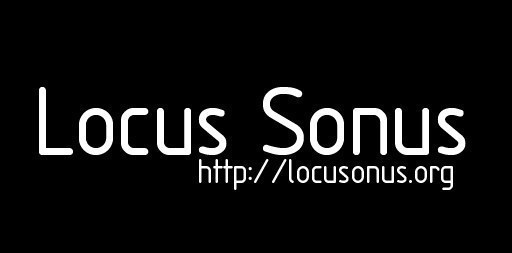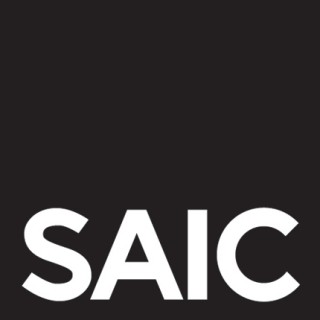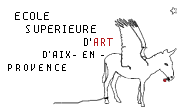|
Menu : R & D
Menu : Valorisation
• 2005-2008 - FACE FRENCH-AMERICAN ACADEMIC PARTNERSHIPS
Partners
- SAIC School of the Art Institute of Chicago (US)
- LOCUS SONUS, École Supérieure d'Art d'Aix en Provence (F)
Project
Franco Americain exchanges In Art and New Media
The Ecole Supérieure d'Art d'Aix-en-Provence (ESAA) is embarking on a partnership with the School of the Art Institute of Chicago’s (SAIC) Art and Technology Studies (ATS) and Sound departments. We propose to create an academic network that harbors current technological research in sound, immersive environments, telecommunications, kinetic art and robotics, while identifying complementary coursework and co-validated curriculum. The cooperative will generate faculty and student exchanges and collaborations, collective teaching practices, and reciprocal evaluation of students. We have identified educational content specific to this mission that is relevant to each of our goals. Our ultimate aim is to develop an agenda which involves equal commitment and participation between us in order to award, over a three-year span, an integrated Master’s Degree and, if possible, joint validation. The training covered by these collaborations will offer a unique educational context, correlating art and research—articulating common methodology that spans the sciences and arts; indeed defining research in a studio art context—and fostering professionalism within an environment of cultural exchange. A prelude to this project began through a relationship with the Ecole Nationale Supérieure d'Art Villa Arson Nice and the SAIC between 1999 and 2003, under the auspices of the SCAN (Studio Création Arts Numériques), which was discontinued in July 2003 by the Villa Arson (see history below). Today, we hope to expand the faculty visits and the activities we successfully began into a post-graduate research program for exchange students, led by the same professors Jérôme Joy (at Aix and Nice) and Peter Gena (Chicago), along with Peter Sinclair in Aix and Benjamin Chang in Chicago.
The projected program proposes student exchanges, faculty exchanges, shared teaching projects included in curriculum and courses shared between the two institutions using remote teaching and video conferencing. We are working towards a shared degree.
Exchanges (average over 3 years): Students 6 per year for one semester. Teachers 6 per year for 2 weeks.
Exchange professors will teach seminars and/or direct workshops related to their personal specialty proposing, at the same time, a focus on cultural and art history issues specific to their home country.
Lessons and conferences will be shared on line using video-conferencing techniques. Shared teaching projects will focus on networked art. Language lessons will be made available to visiting students and faculty.
Students visiting France will benefit from the network, which ESAA has established for its specialized cycle "Locus Sonus - Audio in Art": IRCAM, GMEM, STEIM etc. and their work will be presented publicly. SAIC possesses it's own downtown exhibition space which could be made available to visiting students.
Primary objectives are to consolidate an existing exchange program which was started in 1999, develop a shared teaching program based on different types of data transmission and to provide a professionalizing experience in an international context for students engaged in the program.
Shared Projects
Shared Research Projects/Class Projects:
- 1. Hyper table and related dynamic surfaces. (Ben Chang and Douglas Stanley).
Interactive media through projection and motion sensors.
- 2. Cave (immersive environments lab). (Ben Chang, Ricardo Garcia, and Robb
Drinkwater [SAIC, Sound assistant adjunct professor], France Cadet).
Virtual reality experiments and classes.
- 3. Streaps/Networked-audio system. (Peter Sinclair, Peter Gena, Jérôme Joy, and
Robb Drinkwater). Simultaneous concerts and projects on both sides of the
Atlantic. Research includes, signal processing, music as data representation,
algorithmic composition, etc.
- 4. Data pipe (internet line between SAIC and ESAA) for interactivity (picoIP,
Maliki Farrel). Christian Soucaret, Ed Bennett, Jean Pierre Mandon, France
Cadet and Peter Sinclair). This allows communications between the two
institutions for use by items 1 to 3 above, and more.
Platforms for Discourse:
- 1. Blog. (Douglas Stanley and Sylvia Ruzanka). Informative working progress
report for the entire community.
- 2. Shared curriculum (Ben Chang, Douglas Stanley, Peter Gena and Peter
Sinclair). Online lessons that could lead to shared classes between two
institutions; live and virtual.
- 3. Critique online rendezvous. (Douglas Stanley, Ben Chang, Peter Gena and Peter
Sinclair)
- 4. Visiting Bi-weekly meetings for students with designated tutor {live and virtual}.
(Douglas Stanley, Ben Chang, Peter Gena and Peter Sinclair).
- 5. Permanent AccessCam, IPcam. (Ed Bennett and Peter Sinclair).
- 6. Virtual Artists Lecture Series. Simultaneous presentations broadcast over the internet in
front of audiences on both sides of the Atlantic.
version française
Projet
Échanges Franco Américain en Art et Nouveaux Medias
Le programme que nous proposons porte sur des échanges d’étudiants, des échanges d’enseignants, des projets pédagogiques partagés inscrits dans le curriculum des deux établissements et des cours partagés en ligne (télé-enseignement). Nous travaillons vers un diplôme partagé.
Les échanges en moyenne sur 3 ans: Etudiants 6 par an, pour 1 semestre. Enseignants 6 par an, pour 2 semaines.
Les professeurs en échange donneront un enseignement, sous forme de séminaires et/ou d’ateliers intensifs (workshops), axé sur leur spécialité propre et enrichi d’une approche culturelle dirigée sur l’histoire et l’actualité artistique du pays d’origine.
Des cours seront retransmis en ligne entre les écoles, les projets d’enseignement partagés se porteront essentiellement sur des questions de création en ligne et des cours de langue seront disponibles dans l’établissement d’accueil pour étudiants et professeurs.
Les étudiants en visite en France bénéficièront du réseau mise en place par ESAA, dans le cadre de son cycle spécialisé en création sonore "Locus Sonus": IRCAM, GMEM, STEIM etc. Leur travail sera présenté publiquement. SAIC possède son propre espace d’exposition qui pourra être mis à la disposition des étudiants en provenance d’Aix-En-Provence.
L’objectif est de pérenniser et de développer les échanges existants depuis 1999, d’engager un enseignement partagé, par le biais de la télé-enseignement, et de proposer une ouverture internationale et professionnalisante aux étudiants engagés dans le programme.
English version
Description of the Partnership
The proposed areas of inquiry, Audio Art, Electronic Music, Video, Computer programming, Networked Art,
Immersive Environments, and Robotics naturally lean towards trans-disciplinary practice. We intend to establish a
shared art and technology platform that will dynamically enrich the curriculum of each institution. Within the
structure of the proposed academic partnership, exchange students will have access to the research resources of each
host facility. Moreover, faculty exchanges will extend and increase resources of the host educational program with
an eye towards identifying and building upon common research and experimentation. Immersion in a less familiar
environment will afford students the opportunities to enrich content and reinforce cultural references relative to their
artistic projects. They will also benefit from the implementation of their work within the larger, international
milieu. The benefits of cultural diversity clearly work immediately in both directions as students at the host
facilities benefit from fresh input from their visiting peers.
At the SAIC, MFA’s are primarily based on Graduate Projects (one-on-one private tutorials) graduate seminar
classes, and art history requirements. There are no “requirements” per se in terms of course sequences in each
discipline. We simply give an MFA, not a Masters in Sound, or Art and technology, etc. Hence, most of our
technical courses are at the advanced undergraduate level. It is quite common for entering graduate students, who
wish to hone certain skills, to enroll in these classes. The offerings include courses and workshops in immersive
VR, telecommunication, robotics, 3D animation, machine control electronics, art of surveillance, internet-based art,
algorithmic composition, automated composition, sound-spatialization, cognitive psychology, digital sound,
hardware hacking, etc. Our graduate seminars in ATS and Sound feature a variety of topics from specialized
electronic and kinetic issues, art and biology, telecommunications, sound composition, etc. We envision that
visiting students from Aix would avail themselves of these courses in addition to the six to nine hours of Graduate
Projects that deal with the student’s own work (which would specialize in the areas that we expect to concentrate on
in the exchange). Similarly, SAIC students would pursue courses and workshops at Locus Sonus in Audio and
Space: installation, mobility, architectural space, virtual space, public space, interactivity, narrative, context,
augmented reality; and Networked Audio Systems: group, experimental collectives, artistic collectives, game
collectives, digital-audio marching bands, streaming, radioblogs, transfer protocols, downloading, consensual and
participatory protocols, interfaces, streams, listening apparatuses. In addition we expect that the fruits of our
collaborative labors will integrate the students and progress as follows.
Year 1 (2005-2006): Faculty and students will begin developing resources and platforms for tele-collaborative art at
the two institutions: virtual reality facilities, tele-robotics, and systems for streaming and broadcasting digital audio
and video. As each institution has expertise in complementary areas and specializations, this first phase of the
project will focus on developing shared technological infrastructure, as well as aesthetic and conceptual interests for
continuing research projects.
Year 2 (2006-2007): Student exchange focuses on integration of tele-collaborative technologies into specific
projects. These projects will be conducted through the existing academic frameworks for graduate students at SAIC
and ESAA (at SAIC, through graduate seminars and faculty advisers, and selected courses). In addition, we expect
that our telecommunications infrastructure will afford us the opportunity to offer simultaneous internet broadcasts of
concerts, immersive events, exhibits, etc., on both sides of the Atlantic.
Year 3 (2007-2008): SAIC and ESAA offer a co-taught seminar in art and tele-collaboration. Students at both
institutions, including those participating in the exchange, will produce collaborative artworks using networked
video, sound, robotics, and virtual reality technologies. These same technologies, particularly videoconferencing,
will be used to facilitate class meetings between students in Chicago and students in Aix. To create a process of
shared distance learning, instructors at each institution will also use videoconferencing to facilitate remote lectures.
Non-real-time network technologies (email lists, IRC and instant messenger, Wiki‚s, etc.) will be used to
supplement real-time interactions to broaden the discourse between the two groups of students, and to address
practical issues of language and time zone differences. The students directly involved in the exchange will play an
important role as facilitators of the dialogue between students at the two institutions.
Historical time-line
- May 1999: Danielle Brughera, French cultural attaché in Chicago, sponsored a mission to France for Peter Gena
(professor, SAIC) to visit prospective collaborators in Paris, Lyon, and Nice. One of Peter's goals was to
meet Professor Jérôme Joy at L’Ecole Nationale Supérieure d’Art de Nice (Villa Arson). Over several days,
Jérôme and Peter toured the school and exchanged ideas.
- May 2000: Peter Gena taught a Summer Study Trip class for the SAIC in Nice and Florence). Jérôme arranged
for free lodging at the Ecole Nationale Supérieure d'Art for Peter, and twenty-two students! Jérôme and Peter
met with the directors of the Villa Arson and the school, introducing research and exchange ideas.
- April 2001: School of the Art Institute of Chicago
Jérôme Joy (L’Ecole Nationale Supérieure d’Art de Nice), Visiting Artist
- April 3, Sound Art, a play-list, History of Sonic Arts class: 9:30 AM - 12 noon.
- April 4, AM: met with the SAIC foreign study coordinator. 5 PM: Northwestern U.: homestudio.thing.net.
- April 5, AM: SAIC: Intro to Sound class. PM: listened/critiqued student work.
- October 2002: L’Ecole Nationale Supérieure d’Art de Nice
Peter Gena (School of the Art Institute of Chicago), Visiting Artist
- October 3: Villa Arson - SCAN – AudioLab, 1) Lecture Topic: The Art & Technology Department at the
SAIC and new investigations in music, including a presentation of Peter's recent work, using Max/MSP. 2)
Peter and Jérôme met with the co-directors of student exchange at the Villa Arson.
- October 4: Research discussion with Jérôme and assistants.
- February 2003: School of Art Institute of Chicago
Jérôme Joy, Visiting Artist
- February 18: NETSOUND, discussion in the Introduction to Sound class.
- February 19, AM: FREEMODULOPHONICS, pacJAP/picNIC (digital Sound and 4D classes) - description of
the projects and the Max/Msp patches.
- PM: Jérôme and Peter met with Anthony Jones, president of the SAIC.
- February 20, AM: FREEMODULOPHONICS, pacJAP & picNIC (ATS, Interactive Multimedia and
Introduction to Sound classes) - presentation of the projects and description of the Max/Msp patches.
- PM: AUDIOLAB, AGGLO & SCAN, Presentation to SAIC students about exchange with the Villa Arson.
- February 21: PIZMO (Immersive Environments class) - presentation of the collective project and listening.
- May, 2003: L’Ecole Nationale Supérieure d’Art de Nice (SCAN (Studio Création Arts Numériques)
Benjamin Chang (assistant Professor, SAIC), offered a workshop on the basics of a virtual reality
environment. May was the preferred month because of the RadioMatic workshop scheduled at that time.
- June 2003: School of Art Institute of Chicago, AudioLab Villa Arson, Nice, RadioStudio Bauhaus-University of
Weimar, Musabi Musashino University, Tokyo, ESAA, Aix-en-Provence, EBA, Avignon, ESBAM, Marseille.
Radiomatic/Streaps: School of the Art Institute of Chicago, Art and Technology Studies.
Christopher Sorg (part-time instructor, SAIC), successfully tests streaming with the above institutions.
- January 2004: L’Ecole Supérieure d'Art d’Aix-en-Provence
Jérôme Joy proposed that the SAIC enter into a new project with Locus Sonus as a new model for
Franco-American exchange. SCAN, in Nice, was discontinued in July 2003, and the programs already launched
(RadioMatic, STREAPS, etc.) have moved to Aix-en-Provence, accompanied by Professor Joy.
- December 2004: School of the Art Institute of Chicago
Peter Sinclair (Professor, L’Ecole Supérieure d'Art d’Aix-en-Provence) Visiting Artist
- December 3, AM: Meeting with Cultural Attaché Yannick Mercoyrol, Gena, Chang, and Christian Tual
(speaker phone).
- PM: presentation to SAIC students and ATS faculty on ESAA, student and faculty
work.
- December 4, AM: planning session for FACE application with Benjamin Chang, and Peter Gena.
- December 8, AM: meeting regarding FACE application with Christian Tual in NYC.
- March 2005: L’Ecole Supérieure d'Art d’Aix-en-Provence
Peter Gena, Visiting Artist
March 1 to 9: Mini-workshops, critiques, and presentations, including work of SAIC faculty and
students.
|






